by Calculated Risk on 5/24/2018 08:43:00 PM
Thursday, May 24, 2018
Friday: Durable Goods
Friday:
• At 8:30 AM, Durable Goods Orders for April from the Census Bureau. The consensus is for a 1.3% decrease in durable goods orders.
• At 9:20 AM, Panel Discussion, Fed Chair Jerome Powell, Financial Stability and Central Bank Transparency, At the Sveriges Riksbank Conference: 350 Years of Central Banking--The Past, The Present and The Future, Stockholm, Sweden
• At 10:00 AM, University of Michigan's Consumer sentiment index (Final for May). The consensus is for a reading of 99.0, up from 98.8.
Housing Inventory Tracking
by Calculated Risk on 5/24/2018 03:59:00 PM
Update: Watching existing home "for sale" inventory is very helpful. As an example, the increase in inventory in late 2005 helped me call the top for housing.
And the decrease in inventory eventually helped me correctly call the bottom for house prices in early 2012, see: The Housing Bottom is Here.
And in 2015, it appeared the inventory build in several markets was ending, and that boosted price increases.
I don't have a crystal ball, but watching inventory helps understand the housing market.
Here is a table from housing economist Tom Lawler showing the year-over-year (YoY) change for National inventory from the NAR, and the YoY change for California from the CAR.
It appears the YoY declines are slowing nationally, and inventory has started to increase YoY in California.
| YOY % Change, Existing SF Homes for Sale | ||
|---|---|---|
| NAR (National) | CAR (California) | |
| Sep-17 | -8.4% | -11.2% |
| Oct-17 | -10.4% | -11.5% |
| Nov-17 | -9.7% | -11.5% |
| Dec-17 | -11.5% | -12.0% |
| Jan-18 | -9.5% | -6.6% |
| Feb-18 | -8.6% | -1.3% |
| Mar-18 | -7.2% | -1.0% |
| Apr-18 | -6.3% | 1.9% |
The graph below shows the year-over-year change for non-contingent inventory in Las Vegas, Phoenix and Sacramento (through April), and also total existing home inventory as reported by the NAR (also through April 2018).
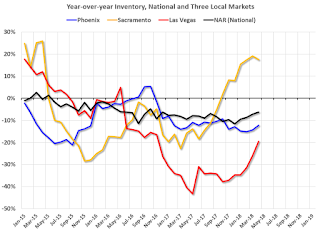 Click on graph for larger image.
Click on graph for larger image.This shows the year-over-year change in inventory for Phoenix, Sacramento, and Las Vegas. The black line if the year-over-year change in inventory as reported by the NAR.
Note that inventory in Sacramento was up 18% year-over-year in April (inventory was still very low), and has increased year-over-year for seven consecutive months.
Also note that inventory is still down in Las Vegas (red), but the YoY decline has been getting smaller.
Inventory is a key for the housing market, and I will be watching inventory for the impact of the new tax law and higher mortgage rates on housing. Currently I expect national inventory to be up YoY by the end of 2018 (but still be low).
A Few Comments on April Existing Home Sales
by Calculated Risk on 5/24/2018 01:08:00 PM
Earlier: NAR: "Existing-Home Sales Slide 2.5 Percent in April"
A few key points:
1) As usual, housing economist Tom Lawler's forecast was closer to the NAR report than the consensus. See: Lawler: Early Read on Existing Home Sales in April.
2) Inventory is still very low and falling year-over-year (YoY) with inventory down 6.3% year-over-year in March). This was the 35th consecutive month with a year-over-year decline in inventory, however the YoY declines have been getting smaller. And some areas of the country are now reporting YoY increases in inventory.
More inventory would probably mean smaller price increases, and less inventory somewhat larger price increases.
The following graph shows existing home sales Not Seasonally Adjusted (NSA).
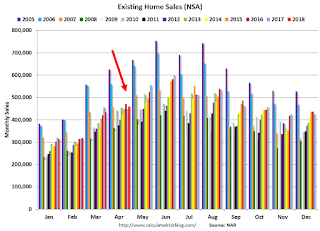
Sales NSA in April (460,000, red column) were above sales in April 2017 (447,000, NSA).
Sales NSA through April are down about 1% from the same period in 2017.
This is a small decline - and it is too early to tell if there is an impact from higher interest rates and / or the changes to the tax law on home sales.
And here is another update to the "distressing gap" graph that I first started posting a number of years ago to show the emerging gap caused by distressed sales. Now I'm looking for the gap to close over the next several years.
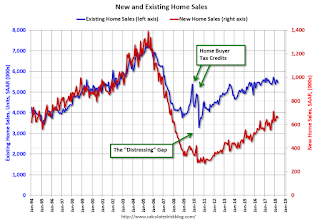
Following the housing bubble and bust, the "distressing gap" appeared mostly because of distressed sales. The gap has persisted even though distressed sales are down significantly, since new home builders focused on more expensive homes.
I expect existing home sales to move more sideways, and I expect this gap to slowly close, mostly from an increase in new home sales.
However, this assumes that the builders will offer some smaller, less expensive homes. If not, then the gap will persist.

This ratio was fairly stable from 1994 through 2006, and then the flood of distressed sales kept the number of existing home sales elevated and depressed new home sales. (Note: This ratio was fairly stable back to the early '70s, but I only have annual data for the earlier years).
In general the ratio has been trending down since the housing bust, and this ratio will probably continue to trend down over the next several years.
Note: Existing home sales are counted when transactions are closed, and new home sales are counted when contracts are signed. So the timing of sales is different.
Kansas City Fed: Regional Manufacturing Activity "Continued to Expand Rapidly" in May
by Calculated Risk on 5/24/2018 11:00:00 AM
From the Kansas City Fed: Tenth District Manufacturing Activity Continued to Expand Rapidly
The Federal Reserve Bank of Kansas City released the May Manufacturing Survey today. According to Chad Wilkerson, vice president and economist at the Federal Reserve Bank of Kansas City, the survey revealed that Tenth District manufacturing activity continued to expand at a rapid pace, and optimism remained high for future activity.So far all of the regional Fed surveys have shown strong growth in May.
“Our composite index rose to another record high in May, with continued optimism for future growth,” said Wilkerson. “Prices indexes were stable but remained at high levels.”
...
The month-over-month composite index was 29 in May, up from readings of 26 in April and 17 in March. The composite index is an average of the production, new orders, employment, supplier delivery time, and raw materials inventory indexes. Factory activity increased at both durable and nondurable goods plants, particularly at nondurable plants producing chemicals and food. Most month-over-month indexes continued to rise. The production index jumped from 33 to 41, and the shipments, new orders, and new orders for exports indexes also moved higher. In contrast, the order backlog and employment indexes eased somewhat. The raw materials inventory index edged up from 17 to 19, and the finished goods inventory index also increased.
emphasis added
NAR: "Existing-Home Sales Slide 2.5 Percent in April"
by Calculated Risk on 5/24/2018 10:09:00 AM
From the NAR: Existing-Home Sales Slide 2.5 Percent in April
After moving upward for two straight months, existing-home sales retreated in April on both a monthly and annualized basis, according to the National Association of Realtors®. All four major regions saw no gain in sales activity last month.
Total existing-home sales, which are completed transactions that include single-family homes, townhomes, condominiums and co-ops, decreased 2.5 percent to a seasonally adjusted annual rate of 5.46 million in April from 5.60 million in March. With last month’s decline, sales are now 1.4 percent below a year ago and have fallen year-over-year for two straight months.
...
Total housing inventory at the end of April increased 9.8 percent to 1.80 million existing homes available for sale, but is still 6.3 percent lower than a year ago (1.92 million) and has fallen year-over-year for 35 consecutive months. Unsold inventory is at a 4.0-month supply at the current sales pace (4.2 months a year ago).
emphasis added
 Click on graph for larger image.
Click on graph for larger image.This graph shows existing home sales, on a Seasonally Adjusted Annual Rate (SAAR) basis since 1993.
Sales in April (5.46 million SAAR) were 2.5% lower than last month, and were 1.4% below the April 2017 rate.
The second graph shows nationwide inventory for existing homes.
 According to the NAR, inventory increased to 1.80 million in April from 1.67 million in March. Headline inventory is not seasonally adjusted, and inventory usually decreases to the seasonal lows in December and January, and peaks in mid-to-late summer.
According to the NAR, inventory increased to 1.80 million in April from 1.67 million in March. Headline inventory is not seasonally adjusted, and inventory usually decreases to the seasonal lows in December and January, and peaks in mid-to-late summer.The last graph shows the year-over-year (YoY) change in reported existing home inventory and months-of-supply. Since inventory is not seasonally adjusted, it really helps to look at the YoY change. Note: Months-of-supply is based on the seasonally adjusted sales and not seasonally adjusted inventory.
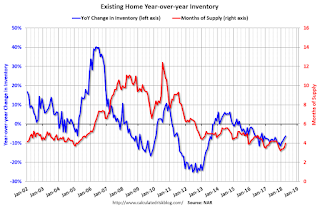 Inventory decreased 6.3% year-over-year in April compared to April 2017.
Inventory decreased 6.3% year-over-year in April compared to April 2017. Months of supply was at 4.0 months in April.
Sales were below the consensus view. For existing home sales, a key number is inventory - and inventory is still low. I'll have more later ...
Weekly Initial Unemployment Claims increase to 234,000
by Calculated Risk on 5/24/2018 08:33:00 AM
The DOL reported:
In the week ending May 19, the advance figure for seasonally adjusted initial claims was 234,000, an increase of 11,000 from the previous week's revised level. The previous week's level was revised up by 1,000 from 222,000 to 223,000. The 4-week moving average was 219,750, an increase of 6,250 from the previous week's revised average. The previous week's average was revised up by 250 from 213,250 to 213,500.The previous week was revised up.
Claims taking procedures in Puerto Rico and in the Virgin Islands have still not returned to normal.
emphasis added
The following graph shows the 4-week moving average of weekly claims since 1971.
 Click on graph for larger image.
Click on graph for larger image.The dashed line on the graph is the current 4-week average. The four-week average of weekly unemployment claims increased to 219,750.
This was higher than the consensus forecast. The low level of claims suggest few layoffs.
Wednesday, May 23, 2018
Thursday: Unemployment Claims, Existing Home Sales
by Calculated Risk on 5/23/2018 08:31:00 PM
Thursday:
• At 8:30 AM ET: The initial weekly unemployment claims report will be released. The consensus is for 220 thousand initial claims, down from 222 thousand the previous week.
• At 9:00 AM: FHFA House Price Index for March 2018. This was originally a GSE only repeat sales, however there is also an expanded index.
• At 10:00 AM: Existing Home Sales for April from the National Association of Realtors (NAR). The consensus is for 5.60 million SAAR, unchanged from 5.60 million in March. Housing economist Tom Lawler estimates the NAR will reports sales of 5.48 million SAAR for April.
• At 11:00 AM: the Kansas City Fed manufacturing survey for May.
Philly Fed: State Coincident Indexes increased in 45 states in April
by Calculated Risk on 5/23/2018 06:31:00 PM
From the Philly Fed:
The Federal Reserve Bank of Philadelphia has released the coincident indexes for the 50 states for April 2018. Over the past three months, the indexes increased in 49 states and decreased in one, for a three-month diffusion index of 96. In the past month, the indexes increased in 45 states, decreased in one, and remained stable in four, for a one-month diffusion index of 88.Note: These are coincident indexes constructed from state employment data. An explanation from the Philly Fed:
emphasis added
The coincident indexes combine four state-level indicators to summarize current economic conditions in a single statistic. The four state-level variables in each coincident index are nonfarm payroll employment, average hours worked in manufacturing by production workers, the unemployment rate, and wage and salary disbursements deflated by the consumer price index (U.S. city average). The trend for each state’s index is set to the trend of its gross domestic product (GDP), so long-term growth in the state’s index matches long-term growth in its GDP.
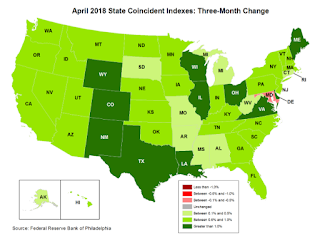 Click on map for larger image.
Click on map for larger image.Here is a map of the three month change in the Philly Fed state coincident indicators. This map was all red during the worst of the recession, and all or mostly green during most of the recent expansion.
Once again, the map is almost all green on a three month basis.
Source: Philly Fed.
Note: For complaints about red / green issues, please contact the Philly Fed.
 And here is a graph is of the number of states with one month increasing activity according to the Philly Fed. This graph includes states with minor increases (the Philly Fed lists as unchanged).
And here is a graph is of the number of states with one month increasing activity according to the Philly Fed. This graph includes states with minor increases (the Philly Fed lists as unchanged).In April, 48 states had increasing activity (including minor increases).
The downturn in 2015 and 2016, in the number of states increasing, was mostly related to the decline in oil prices.
Black Knight: National Mortgage Delinquency Rate Decreased in April, Foreclosure Inventory Lowest since August 2006
by Calculated Risk on 5/23/2018 02:38:00 PM
From Black Knight: Black Knight’s First Look: Mortgage Delinquencies Buck Upward Seasonal Trend in April, Fall to Second Lowest Point in 12 Years
• Historically, mortgage delinquencies have risen 85 percent of the time in April; this month they declined 1.6 percent – about equal to the size of their average usual increaseAccording to Black Knight's First Look report for April, the percent of loans delinquent decreased 1.6% in April compared to March, and decreased 10.2% year-over-year.
• April’s improvement halted a seven-month trend of annual increases in the national delinquency rate
• Areas impacted by Hurricanes Harvey and Irma led April’s delinquency improvement, but slight declines were seen in non-affected areas as well
• Over 90,000 seriously delinquent mortgages (90 or more days past due) attributed to the 2017 hurricane season remain in affected areas of Texas, Florida and Georgia
• The number of mortgages in active foreclosure hit its lowest point since August 2006
The percent of loans in the foreclosure process decreased 2.3% in April and were down 28.4% over the last year.
Black Knight reported the U.S. mortgage delinquency rate (loans 30 or more days past due, but not in foreclosure) was 3.67% in April, down from 3.73% in March.
The percent of loans in the foreclosure process decreased in April to 0.61%.
The number of delinquent properties, but not in foreclosure, is down 187,000 properties year-over-year, and the number of properties in the foreclosure process is down 119,000 properties year-over-year.
| Black Knight: Percent Loans Delinquent and in Foreclosure Process | ||||
|---|---|---|---|---|
| Apr 2018 | Mar 2018 | Apr 2017 | Apr 2016 | |
| Delinquent | 3.67% | 3.73% | 4.08% | 4.24% |
| In Foreclosure | 0.61% | 0.63% | 0.85% | 1.17% |
| Number of properties: | ||||
| Number of properties that are delinquent, but not in foreclosure: | 1,885,000 | 1,912,000 | 2,072,000 | 2,146,000 |
| Number of properties in foreclosure pre-sale inventory: | 314,000 | 321,000 | 433,000 | 820,000 |
| Total Properties | 2,199,000 | 2,232,000 | 2,505,000 | 2,741,000 |
FOMC Minutes: "A temporary period of inflation modestly above 2 percent would be consistent with inflation objective"
by Calculated Risk on 5/23/2018 02:14:00 PM
Still on pace for 3 or 4 rate hikes in 2018. Some excerpts:
From the Fed: Minutes of the Federal Open Market Committee, May 1-2, 2018:
With regard to the medium-term outlook for monetary policy, all participants reaffirmed that adjustments to the path for the policy rate would depend on their assessments of the evolution of the economic outlook and risks to the outlook relative to the Committee's statutory objectives. Participants generally agreed with the assessment that continuing to raise the target range for the federal funds rate gradually would likely be appropriate if the economy evolves about as expected. These participants commented that this gradual approach was most likely to be conducive to maintaining strong labor market conditions and achieving the symmetric 2 percent inflation objective on a sustained basis without resulting in conditions that would eventually require an abrupt policy tightening. A few participants commented that recent news on inflation, against a background of continued prospects for a solid pace of economic growth, supported the view that inflation on a 12-month basis would likely move slightly above the Committee's 2 percent objective for a time. It was also noted that a temporary period of inflation modestly above 2 percent would be consistent with the Committee's symmetric inflation objective and could be helpful in anchoring longer-run inflation expectations at a level consistent with that objective.
emphasis added


